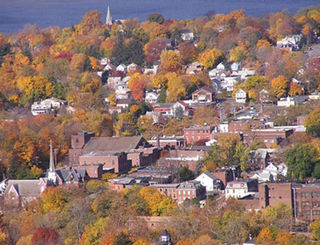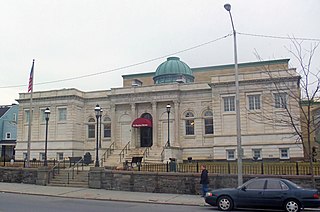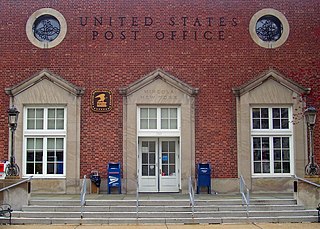
Beacon is a city located on the Hudson River in Dutchess County, New York, United States. As of the 2020 census, the city's population was 13,769. Beacon is part of the Kiryas Joel–Poughkeepsie–Newburgh Metropolitan Statistical Area as well as the larger New York–Newark–Bridgeport, New York–New Jersey–Connecticut–Pennsylvania Combined Statistical Area.

Wappingers Falls is a village in the towns of Poughkeepsie and Wappinger, in Dutchess County, New York, United States. As of the 2010 census it had a population of 5,522. The community was named for the cascade in Wappinger Creek. The Wappingers Falls post office covers areas in the towns of Wappinger, Poughkeepsie, Fishkill, East Fishkill, and LaGrange. This can result in some confusion when residents of the outlying towns, who do not live in the village, give their address as "Wappingers Falls".

The Adriance Memorial Library is located on Market Street in Poughkeepsie, New York, United States. It is a stone building in the Classical Revival architectural style erected shortly at the end of the 19th century. In 1982 it was listed on the National Register of Historic Places.

The U.S. Post Office in Goshen, New York, United States, is located on Grand Street downtown in the village of Goshen. It serves ZIP Code 10924, roughly contiguous with the village and town. The brick Colonial Revival building was completed in 1936, and added to the National Register of Historic Places in 1989.

The former Lewis Tompkins Hose Company No. 1 Firehouse, sometimes known as 5/33, was the first built in what later became the city of Beacon, New York. Designed by Schuyler Tillman and Benjamin Hall in a Second Empire style, it was completed in 1893. It is located at 162 Main Street, a block away from NY 9D, and was listed on the National Register of Historic Places on December 6, 2004.

The U.S. Post Office in Rhinebeck, New York serves the 12572 ZIP Code. It is located on Mill Street just south of the intersection with NY 308 at the center of the village.

The U.S. Post Office in Hyde Park, New York, serves the 12538 ZIP Code. It is a stone building in the Dutch Colonial Revival architectural style, located on East Market Street just east of US 9.

The Howland Cultural Center, formerly known as Howland Library, is located on Main Street in Beacon, New York, United States. It is an ornate brick building designed by Richard Morris Hunt in the 1870s. In 1973 it was listed on the National Register of Historic Places.

Formerly the Wappingers Falls Village Hall this building now houses the Police Department. It is located at the corner of South Avenue and East Main Street in the village of Wappingers Falls, Dutchess County, New York.

The main U.S. Post Office, Poughkeepsie, New York, is located at the intersection of Market and Mansion Streets downtown; the address is 55 Mansion Street. The New Deal post office serves the 12601 ZIP Code, which covers the city of Poughkeepsie, New York and portions of the Town of Poughkeepsie adjacent to the city. It employs a hundred people and handles 300,000 pieces of mail a day and 10 million a year.

The U.S. Post Office in Mineola, New York serves the ZIP Code 11501, covering that community in the Towns of North Hempstead and Hempstead, New York, United States, the seat of Long Island's Nassau County. It is located on the northeast corner of the junction of First and Main Streets.

The U.S. Post Office in Middleport, New York, is located at Main and Church streets. It is a brick building erected in 1940, serving the 14105 ZIP Code, which covers the village of Middleport and surrounding areas of the towns of Hartland and Royalton.

The U.S. Post Office in Albion, New York, is located on South Main Street in the center of town. It serves the 14411 ZIP Code, covering the village and town of Albion plus neighboring sections of the towns of Barre and Gaines.

The U.S. Post Office in Medina, New York, is located at West Avenue and West Center Street. It is a brick building erected in the early 1930s, serving the ZIP Code 14103, covering the village of Medina and neighboring portions of the towns of Ridgeway and Shelby.

The U.S. Post Office in Le Roy, New York, serves the 14482 ZIP Code, covering the village and town of Le Roy. It is a brick and stone building on Main Street erected in the late 1930s.

The Storm–Adriance–Brinckerhoff House is located on Beekman Road in East Fishkill, New York, United States. It is a wooden building in three parts, the oldest of which dates to the mid-18th century.

The U.S. Post Office in Spring Valley, New York, is located on North Madison Street. It is a brick building from the mid-1930s that serves the ZIP Code 10977, covering the village of Spring Valley.

The U.S. Post Office in Pearl River, New York, is located at the junction of Franklin and Main streets in the hamlet's downtown. It is a brick building from the mid-1930s, serving the ZIP Code 10965, which covers the hamlet of Pearl River.

The United States Post Office Lenox Hill Station is located at 217 East 70th Street between Second and Third Avenues in the Lenox Hill neighborhood of the Upper East Side, Manhattan, New York City. It is a brick building constructed in 1935 and designed by Eric Kebbon in the Colonial Revival style, and is considered one of the finest post offices in that style in New York State. It was listed on the National Register of Historic Places in 1989, along with many other post offices in the state.

The Walter Merchant House, on Washington Avenue in Albany, New York, United States, is a brick-and-stone townhouse in the Italianate architectural style, with some Renaissance Revival elements. Built in the mid-19th century, it was listed on the National Register of Historic Places in 2002.





















